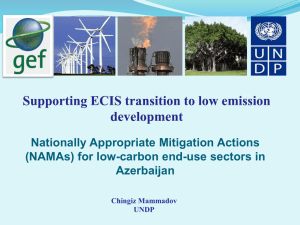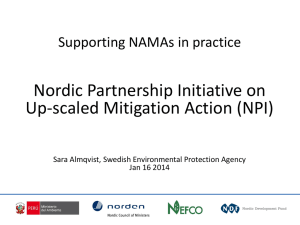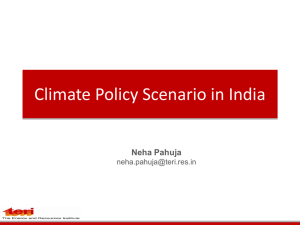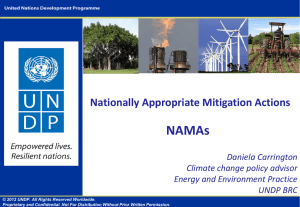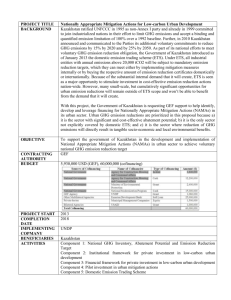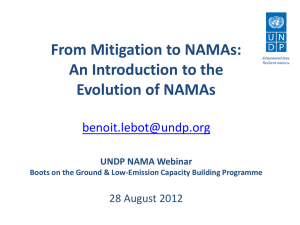PIMS5138 AZE NAMA v6
advertisement
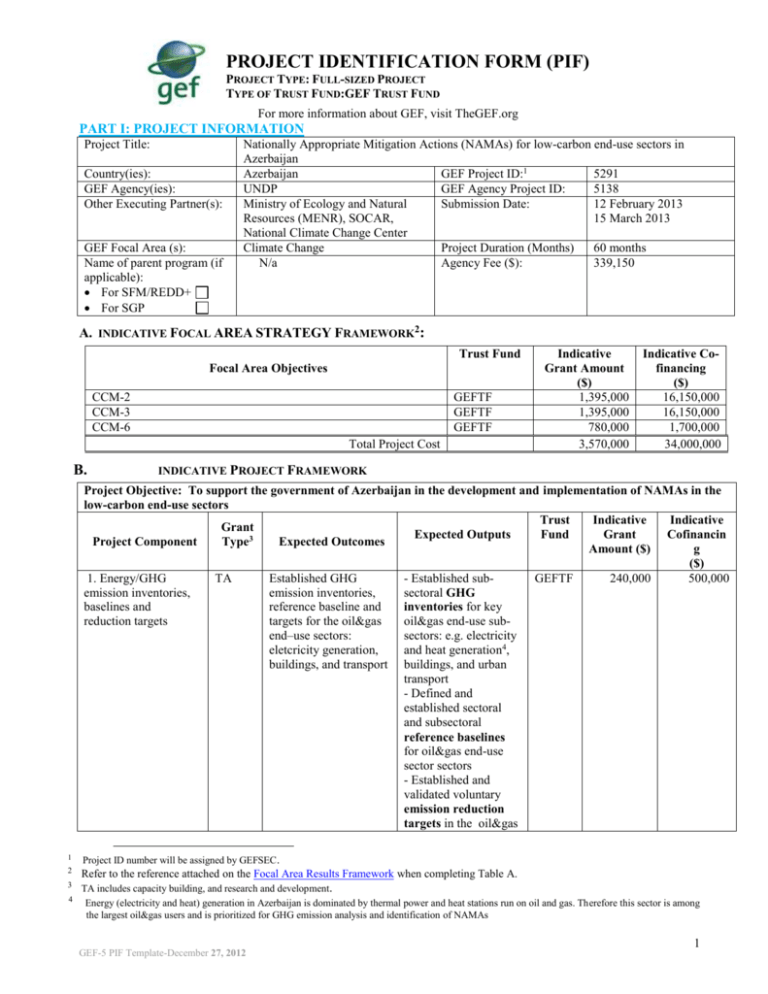
PROJECT IDENTIFICATION FORM (PIF) PROJECT TYPE: FULL-SIZED PROJECT TYPE OF TRUST FUND:GEF TRUST FUND For more information about GEF, visit TheGEF.org PART I: PROJECT INFORMATION Project Title: Country(ies): GEF Agency(ies): Other Executing Partner(s): GEF Focal Area (s): Name of parent program (if applicable): For SFM/REDD+ For SGP Nationally Appropriate Mitigation Actions (NAMAs) for low-carbon end-use sectors in Azerbaijan Azerbaijan GEF Project ID:1 5291 UNDP GEF Agency Project ID: 5138 Ministry of Ecology and Natural Submission Date: 12 February 2013 Resources (MENR), SOCAR, 15 March 2013 National Climate Change Center Climate Change Project Duration (Months) 60 months N/a Agency Fee ($): 339,150 A. INDICATIVE FOCAL AREA STRATEGY FRAMEWORK2: Trust Fund Focal Area Objectives CCM-2 CCM-3 CCM-6 GEFTF GEFTF GEFTF Total Project Cost B. Indicative Grant Amount ($) 1,395,000 1,395,000 780,000 3,570,000 Indicative Cofinancing ($) 16,150,000 16,150,000 1,700,000 34,000,000 INDICATIVE PROJECT FRAMEWORK Project Objective: To support the government of Azerbaijan in the development and implementation of NAMAs in the low-carbon end-use sectors Trust Indicative Indicative Grant Expected Outputs Fund Grant Cofinancin 3 Project Component Type Expected Outcomes Amount ($) g ($) 1. Energy/GHG TA Established GHG - Established subGEFTF 240,000 500,000 emission inventories, emission inventories, sectoral GHG baselines and reference baseline and inventories for key reduction targets targets for the oil&gas oil&gas end-use subend–use sectors: sectors: e.g. electricity eletcricity generation, and heat generation4, buildings, and transport buildings, and urban transport - Defined and established sectoral and subsectoral reference baselines for oil&gas end-use sector sectors - Established and validated voluntary emission reduction targets in the oil&gas 1 2 3 4 Project ID number will be assigned by GEFSEC. Refer to the reference attached on the Focal Area Results Framework when completing Table A. TA includes capacity building, and research and development. Energy (electricity and heat) generation in Azerbaijan is dominated by thermal power and heat stations run on oil and gas. Therefore this sector is among the largest oil&gas users and is prioritized for GHG emission analysis and identification of NAMAs GEF-5 PIF Template-December 27, 2012 1 2. Development of mitigation actions for oil&gas end-use sectors TA Prioritized feasible NAMAs are developed and capacity built for their design and implementation 3. Implementation of NAMAs in the oil&gas end-use sectors TA Policy and financial framework established Inv Prioritized NAMAs implemented leading to direct GHG emission reduction of 626,000 tCO2 GEF-5 PIF Template-December 27, 2012 end-use sectors - Developed and published detailed marginal abatement cost curves for the oil&gas end-use sectors - Completed comprehensive barrier analysis for mitigation options in oil&gas end- use sector - Three designed programs for the implementation of selected prioritized feasible NAMAs in main oil&gas end-use sub-sectors - Fully capable and qualified private and public sector entities in the design and implementation of NAMAs - Defined and approved policy and regulatory instruments to promote/de-risk investment in prioritized mitigation actions in the oil&gas end-use sectors. - Defined and established financial instruments mitigation actions in the oil&gas end-use sectors, such as gas offset scheme - Three implemented NAMAs in oil&gas end-use sectors, with at least one NAMA utilizing carbon market mechanisms GEFTF 560,000 900,000 GEFTF 800,000 900,000 GEFTF 1,300,000 30,000,000 2 4. MRV system and national registry for mitigation actions in the energy generation and end-use sectors TA Accurate measurement and accounting of actual GHG emission reductions from mitigation actions in the oil&gas end-use sectors -Established and operational national registry mechanism for mitigation actions in the oil&gas end-use sector - MRV Committee established for the selected NAMAs - Developed National MRV guideline and standard methodologies for the selected subsectors - Monitoring plan designed and implemented for the selected NAMAs - Fully capable and qualified local technical professionals in the conduct of MRVs - Analyzed, published and disseminated lessons learned from the implementation of the pilot NAMAs Subtotal Project Management Cost (PMC)5 Total Project Cost C. 500,000 1,000,000 GEFTF 3,400,000 170,000 3,570,000 33,300,000 700,000 34,000,000 INDICATIVE CO-FINANCING FOR THE PROJECT BY SOURCE AND BY NAME IF AVAILABLE, ($) Sources of Cofinancing Name of Cofinancier National Government Private Sector Private Sector GEF Agency Other Multilateral Agency (ies) CSO Total Cofinancing D. GEFTF INDICATIVE TRUST FUND MENR SOCAR SOCAR UNDP EU National Climate Change Center Type of Cofinancing In-kind In-kind Cash Grant Grant In-kind Amount ($) 800,000 900,000 30,000,000 200,000 2,000,000 100,000 34,000,000 RESOURCES ($) REQUESTED BY AGENCY, FOCAL AREA AND COUNTRY1 N/a 5 To be calculated as percent of subtotal. GEF-5 PIF Template-December 27, 2012 3 E. PROJECT PREPARATION GRANT (PPG)6 Please check on the appropriate box for PPG as needed for the project according to the GEF Project Grant: Amount Agency Fee Requested ($) for PPG ($)7 No PPG required. ___-- 0--______ _ --0--_______ (upto) $50k for projects up to & including $1 million ___ ________ _____ _____ (upto)$100k for projects up to & including $3 million _____________ _____________ (upto)$150k for projects up to & including $6 million ___ 100,000__ 9,500___ ___ (upto)$200k for projects up to & including $10 million ___ ________ ___ _____ (upto)$300k for projects above $10 million ___ ________ ___ _____ 6 7 On an exceptional basis, PPG amount may differ upon detailed discussion and justification with the GEFSEC. PPG fee percentage follows the percentage of the GEF Project Grant amount requested. GEF-5 PIF Template-December 27, 2012 4 PART II: PROJECT JUSTIFICATION8 A. PROJECT OVERVIEW A.1. Project Description. Briefly describe the project, including ; 1) the global environmental problems, root causes and barriers that need to be addressed; 2) the baseline scenario and any associated baseline projects, 3) the proposed alternative scenario, with a brief description of expected outcomes and components of the project, 4) incremental cost reasoning and expected contributions from the baseline , the GEFTF, LDCF/SCCF and co-financing; 5) global environmental benefits (GEFTF, NPIF) and adaptation benefits (LDCF/SCCF); 6) innovativeness, sustainability and potential for scaling up 1) Global environmental problems, root causes and barriers that need to be addressed International Context of Nationally Appropriate Mitigation Actions (NAMAs) The concept of NAMAs was introduced in the Bali Action Plan in 2007 (Decision 1 CP/13). The parties to the UNFCCC called for “Enhanced national/international action on mitigation of climate change”. In the Cancun Agreements reached on December 11 2010, the Parties further agreed that “developing country Parties will take nationally appropriate mitigation actions in the context of sustainable development, supported and enabled by technology, financing and capacity-building, aimed at achieving a deviation in emissions relative to ‘business as usual’ emissions in 2020.” The Cancun Agreements also differentiate between NAMAs that are domestically supported and internationally supported, specifying that both are subject to being measured, reported and verified domestically but that the latter, will be subject to international measurement, reporting and verification (MRV). Finally, there is an unequivocal agreement that private sector is the largest source of investment flows for low-carbon technologies and, therefore, has to play a major role in the design and implementation of NAMAs. Azerbaijan’s oil&gas sector, GHG emissions and climate change mitigation targets Azerbaijan is a fast developing, oil and gas oriented economy. According to 2nd National Communication to UNFCCC, Azerbaijan’s annual GHG emissions were 50.6 mln tCO2e/year in 2005 with the energy sector (i.e. combustion of oil&gas) accounting for the largest share of domestic emissions, more than 50% or 31.3 mln tCO2. National annual consumption of oil and gas is now at about 5.2 mln toe, with the residential and transport sectors together accounting for over 90% of end-use (See Table 1). Azerbaijan’s energy intensity (0.71toe/US$) is twice as high as the world’s average (0.3 toe/US$) and nearly 4 times above the level of energy intensity in OECD countries (0.18 toe/US$). There exists, therefore, a significant potential to increase efficiency of oil&gas use and reduce the country’s GHG emissions. Table 1: Azerbaijan’s Total Final Oil&Gas Use, toe Coal and Peat Oil Products Natural Gas TOTAL TFC 0 2541 2678 5219 Industry 0 106 273 379 Transport 0 1534 0 1534 Residential 0 79 2342 2421 Services 0 5 30 35 Agriculture 0 301 5 306 Source: IEA 2010 2) Baseline scenario and projects Having reached the peak of the currently available oil and gas production, Azerbaijan needs to establish a 8 Part II should not be longer than 5 pages. GEF-5 PIF Template-December 27, 2012 5 viable medium and long term strategy for managing and utilizing its energy resources. One important component of such strategy is the utilization of the available renewable energy resources and improving the energy intensity of the economy in order to achieve reduction of the use of gas and oil internally, through replacement of the oil and gas used for generation of electricity by renewable electricity and energy savings. Currently, there are several initiatives led by the Government and the national oil&gas company, SOCAR, which clearly contribute towards this objective, of which the most relevant are described below. BAU Component 1: GHG/Energy baseline and targets As Table 1 shows, Azerbaijan’s baseline emissions are projected to grow nearly two-fold and reach 115.6 MtCO2 by 2025 primarily as a result of increased domestic consumption of oil&gas in the residential, power and transport sectors. Source: Azerbaijan’s NC to UNFCCC The energy sector development in Azerbaijan is guided by two State Programmes: the State Programme for the Development of the Fuel and Energy Sector in Azerbaijan and the State Programme on the Use of Alternative and Renewable Energy Sources in Azerbaijan. These Programmes identify short-term (5 year), mid-term (10 year) and long-term (to 2030) targets for introduction of RES and EE technologies as follows: 1) share of RES in gross domestic power consumption reaches 30% by 2030; 2) efficient use of resources result in saving of equivalent of 3,060 mln m3 of natural gas by 2030; and 3) GHG emissions reduced by 30% in 2030 as compared to 2010 baseline. In addition, the national oil and gas company, SOCAR, has taken even more ambitious voluntary commitment to reduce its own emissions by 40% or by 20 mln tCO2 already by 2020. This commitment and the actions to achieve them are spelled out in the SOCAR’s Climate Change Strategy adopted by the Company’s Board in December 2010. BAU Component 2: Mitigation programmes and policies for oil&gas end-use sectors The afore-mentioned State Programmes also identify specific actions aimed at achieving national targets by 2030. For example, the Action Plan for Energy Efficiency and Reduction of Losses and Technological Consumption of Energy Sector Enterprises has been adopted; the Plan forsees implementation of mandatory metering programs at enterprises and households, measures to reduce technical losses, as well as adoption of normative documents and standards related to utilization, losses and technological consumption of fuel resources by all public entities. The following donor-funded initiatives provide critical support to the Government for implementation of the State Programes: EU Energy Sector Reform Program (2nd Phase for 2014-2020 is under development) aims to develop an integrated and transparent energy strategy that covers the supply, transportation, and use of all energy resources in Azerbaijan. In its 2nd phase in 2014-2020 the Program will assist with identifying and enacting policies and legislative and institutional reforms to promote energy efficiency, energy savings and the greater use of renewable energy sources in all oil&gas end-use sectos. UNDP Promoting Development of Sustainable Energy Project supports development of conducive policy and regulatory framework for energy efficiency and renewable energy, builds technical and institutional capacities for policy enforcement, and facilitates implementation of demonstration sustainable energy projects (such as small hydro power). ADB Economics of Climate Change in Central and West Asia: one of the outputs of this on-going GEF-5 PIF Template-December 27, 2012 6 regional ADB-supported initiative will be the estimation of the costs of climate change mitigation measures in Azerbaijan’s oil&gas end-use sectors, as well as the assessment of the policy and measures needed for low-carbon growth, including market-based mechanisms, energy price setting, carbon taxation, subsidy removal, and urban planning. BAU Component 3: Implementation of mitigation actions in the oil&gas end-use sectors The national oil& gas company, SOCAR, has been at the forefront of national climate change mitigation actions. Apart from adopting bold targets and implementing GHG emission reduction measuress internally, the company is implementing several initiatives to promote more efficient and cleaner oil&gas end-use technologies and practices among its customers and employees. SOCAR’s demand-side management program for natural gas users supports installation of meters and smart-cards for individual and industrial oil&gas end-users. The company has set up an ecological park to popularize zero-carbon technologies, such as wind, solar and energy efficient buildings. SOCAR also announced the plans to act as a RES-project developer and has already started with supplying RES-based energy for its own needs from pilot 40kW wind and 20kW solar projects. The company is designing a 1.5 MW wind park on Jilov island which will provide clean energy to the island’s population of 2,000 and SOCAR’s premises and production facilities located there. The company’s Climate Change Strategy envisages development of new wind parks to provide electricity for its offshore oil&gas fields, as well as other renewable energy projects for electricity and heating of SOCAR’s own buildings and industrial premises in Baku and other cities. BAU Component 4: Monitoring, Reporting and Verification (MRV) for mitigation actions in oil&gas end-use sectors There is currently no comprehensive system in place to monitor the impact of mitigation measures at sectoral or national level. National GHG inventory prepared by the National Climate Change Center under MENR and SOCAR’s corporate GHG inventory represent the first building blocks of such system. Also, under MENR leadership a dozen of CDM projects were developed and implemented in Azerbaijan, including three CDM projects with SOCAR, each involving a project-level MRV system. Technical knowledge and understanding of mitigation activities gathered by the private and public sector through concrete project experiences and the capacity development programmes executed in Azerbaijan during last 10 years (World Bank CF- Assist, UNDP Capacity Building for CDM and EU-TACIS program) serves as a stepping stone for post- 2012 scaled up market mechanisms and sectoral MRVs. 3) Proposed alternative scenario and 4) incremental cost reasoning The proposed project builds upon a strong national commitment to reduce domestic use of gas and oil in the power generation sector, through their replacement for generation of electricity from renewable energy sources, and pursuing energy savings measures. Both SOCAR and the Government acknowledge, however, that reaching their targets and reversing the trend of GHG emissions requires additional efforts, especially on the demand side. In this context, the Government of Azerbaijan is requesting GEF support to help identify, develop and leverage financing for Nationally Appropriate Mitigation Actions (NAMAs) in its oil&gas end-use sector. The GEF project is designed with the objective of leading the end-use sector NAMA development and implementation process. As described in the previous section, there are numerous ongoing initiatives aimed at oil&gas saving and fuel switch in the energy use sectors. The GEF initiative will be immersed in this context and will have the overall mandate of developing a NAMA framework, both coordinating amongst baseline initiatives and complementing these actions to ensure the country is fully enabled to implement structured and integrated energy end-use sector NAMAs. The project will consist of the following four components: Component 1: Business-as-usual GHG emission baseline and reduction targets This component will focus on establishing a GHG business-as-usual reference baseline and emission reduction targets for main oil&gas end-use sector and subsectors. This will enhance and complement the national GHG inventory that is being conducted by the Ministry of Ecology and Natural Resources through the Third National Communication to the UNFCCC (TNC). While the TNC will focus on GEF-5 PIF Template-December 27, 2012 7 national, sector level inventories, this project will prepare detailed sub-sectoral GHG inventories, (e.g. electricity generation, heat generation, buildings, urban transport), reference baseline scenario for identified sub-sectors, and alternative/low-carbon scenarios with accelerated implementation of energy efficiency and renewable energy measures in key sub-sectors. In addition to the preparation of these inventories, a system will be established in the Ministry of Ecology and Natural Resources to facilitate the gathering of information and the update of the sub-sectoral GHG inventories for end-use sectors and enhance their quality. Based on analysis and finding of sectoral baselines and abatement potential, sectoral GHG emission targets will be proposed and adopted. These sectoral targets will be consistent with national and corporate targets, as defined in the State Programme for the Development of the Fuel and Energy Sector and SOCAR’s Climate Change Strategy. Component 2: Development of NAMAs in oil&gas end-use sectors This component will support the Government of Azerbaijan in the identification and development of appropriate mitigation options (NAMAs). A detailed marginal abatement cost curve for main energy enduse sectors (electricity generation, residential, and transport) will be prepared. NAMAs will be identified and their feasibility assessed. From this pipeline of NAMAs, a prioritization exercise will be performed and a short list of three NAMAs will be proposed for implementation under Component 3. NAMA design will include selection of mitigation actions, definition of geographic and sectoral boundaries, evaluation of emission reductions potential, establishment of the timeframe, definition of the monitoring methodology, comprehesnive barrier analysis, selection of appropriate policy and financial instruments and evaluation of the required funding and sources. The implementation of NAMAs and corresponding MRV systems will require strong capacity and readiness of large set of diverse stakeholders, including private sector, professional associations, subnational governments, NGOs and public institutions. The project will strengthen capacity of the required stakeholders in the design and implementation of mitigation programmes and the identification of funding sources and options, as well as MRV requirements. NAMAs will be separated in three categories depending on their characteristics: Unilateral NAMAs, Supported NAMAs and Credited NAMAs. Unilateral NAMAs will include mitigation actions that can be implemented unilaterally by the country, such as measures that have negative costs but need policy reforms to be promoted. The category of Supported NAMAs will be composed of actions that need additional technology transfer and may have higher costs or entry barriers than current common practice. The option of Credited NAMAs will also be explored for mitigation actions that could be enocuraged through market mechanisms and other financial incentives. Component 3: Implementation of NAMAs in the oil&gas end-use sector This component will support implementation of prioritized NAMAs, including both policy and financial instruments (under TA sub-component) and investment (under Inv sub-component). Sub-sectoral scope of pilot NAMAs will be identified and justified at PPG stage. TA sub-component: GEF resources will be used to facilitate policy dialogue and put in place required policy, regulatory and financial instruments to de-risk investment in GHG emission reduction measures. For example, policies to promote more efficient use of oil and gas and switch to renewable energy in the residential sector and electricity generation might include energy/fuel efficiency standards for appliances and buildings, and feed-in tariff for renewables. Financial instruments and incentives will also be proposed. In this respect, exploiting current 11-fold difference between the domestic gas prices and export gas prices, can provide an offset subsidy to the renewables. The project will explore the feasibility of establishing a “gas offset scheme” where gas, replaced by renewable generation/energy saving (“saved gas”) is used for export and the difference between domestic and international price of gas (45AZN/1000m3 – domestic price vis-à-vis 300AZN/1000m3 – export price) can subsidize energy saving or renewable energy projects in prioritized NAMAs. In that respect SOCAR’s full engagement is critical: the company is the only entity in Azerbaijan which can monetize the domestic/international oil and gas price difference and thus serve as a GEF-5 PIF Template-December 27, 2012 8 source of additional financing for NAMA implementation. Other instruments to be assessed are fiscal incentives,a feed-in tariff, and energy performance contracting with ESCOs. For at least one of the selected NAMA, potential scaled up mitigation market mechanisms will be explored and designed, in particular sectoral crediting and voluntary sectoral domestic carbon markets. The sectoral crediting mechanism will require the establishment of sectoral targets and dynamic baseline levels: a sectoral emission target, set below the business as usual (BAU) emissions, will be established, to be accomplished in a given timeframe through the implementation of domestic policies and investment. Through an agreement established with an Annex I country, the Government of Azerbaijan would issue, at the end of the period agreed (ex post), carbon credits for any additional emission reductions below the established targets. At PIF preparation stage, the Government and SOCAR expressed their strong interest in piloting such approach and thus move beyond project-based offsetting mechanisms, such as CDM. Investment sub-component: The exact list of investment projects to be implemented will be defined based on abatement cost curves (to be developed under Component 2) as part of NAMA design. Following is the list of the most promising investment projects based on the preliminary analysis and consultation with partners undertaken at PIF preparation stage: - Energy generation (fuel switch): grid-connected wind power plant to scale up of SOCAR’s pilot investment in 1.5 MW wind project. - Energy use in buildings/heat generation (energy saving/fuel switch): solar water heating and energy efficient retrofits in public and residential buildings Investments required for implementation of NAMAs will be funded through a combination of sources: unilateral NAMAs will be financed by domestic sources, Supported NAMAs will be implemented by a combination of domestic resources and GEF, and Creditted NAMA will be financed from the revenues raised through international carbon markets. GEF resources will not be used to support implementation of credited NAMA to avoid double-counting of resulting GHG emission reductions. Resources allocated by SOCAR for implementation of its climate change strategy, e.g. for demand-side management (smart metering and consumption-based biling) and pilot renewable energy (wind and solar) investment, will represent a baseline funding for this component (15 mln US$). On top of that, SOCAR will allocate additional 15 mln US$ for implementation of prioritized NAMAs as part of company’s political commitment to contribute to climate change mitigation activities and achieve its voluntary target. GEF resources will only be used to provide incremental investment (in proportion of 1 (GEF):23(SOCAR)) in cost-effective GHG emision reduction activities (i.e. below 25 US$/tCO2 or less). As the NAMAs’ design and structure are finalized, additional sources of financing will be identified and leveraged for their implementation including public funds, international cooperation, investment from the private sector and carbon finance. Component 4: MRV system and national registry for mitigation actions in the oil&gas end-use sector MENR, as the governing body in Azerbaijan for climate change, will be in charge of setting a national registry mechanism for mitigation actions. A specific section of the registry will be for actions implemented in the oil&gas end-use sector. Also, specific measurement, reporting and verificitation systems will be established and implemented for the three selected NAMAs through the component 3 of the project. Furthermore, national MRV guidelines and standard methodologies for the selected subsectors will be developed and adopted. A MRV committee will be established for each selected NAMA that will have the responsibility of measuring and collecting data (M), communicate results based on the data collected (R) and verifying the data (V). The committee will also identify specific needs of capacity development for local technical professionals in order to ensure a quality MRV of the NAMAs. Training will be organized on MRV requirements and procedures to enhance technical capacity and ensure the availability of capable and GEF-5 PIF Template-December 27, 2012 9 qualified local technical professionals to conduct MRV for NAMAs in the oil&gas end-use sector 5) Global environmental benefits GHG emission reductions Direct Project Component Component 3: Investment in pilot NAMAs tCO2e (cumulative) 626,000 tCO2 Assumptions/Formula Additional investment in NAMAs: - 1.3 mln $ (GEF) + 15 mln US$ (SOCAR) = 16.3 mln US$ Cost-effectiveness threshold: - 25$/tCO2 (IPCC definition) Direct GHG emission reductions: Investment/cost-effectiveness threshold or 16,300,000 $: 25$/tCO2=626,000 tCO2 (cumulatively over investment lifecycle) Indirect (topdown) Component 3: Policy instruments for NAMA implementation TOTAL 1,518,000 tCO2/year or 15,180,000 tCO2 over project influence period National emission reduction target: 30% Energy sector-emissions from fuel combustion: 50% of the total or 25.3 MtCO2 in BAU (2005 – latest available year from 2NC; 2010 baseline to be estimated by TNC) Energy sector emission reduction target: 7.59 MtCO2/year GEF Causality Factor: 0.2 GEF Influence period: 10 years 15.8 mln tCO2 6) Innovativeness, sustainability and potential for scaling up The project involves application of highly innovative mechanisms in the Azerbaijani and global context, such as, for example, the sectoral carbon market mechanisms and domestic gas offset scheme. It is also for the first time that corporate sector, SOCAR, will be directly involved in design and implementation of NAMAs. Sustainability of the project will be ensured by putting in place appropriate policy and financial de-risking instruments and embedding the concept of NAMAs in relevant national and corporate programs and strategies. It is the project ambition to use a scaled-up approach for emission reductions in main oil&gas end use sectors by piloting implementation of prioritized NAMAs and adoption of sectoral targets. A.2. Stakeholders. Identify key stakeholders (including civil society organizations, indigenous people, gender groups, and others as relevant) and describe how they will be engaged in project preparation: Ministry of Ecology and Natural Resources (MENR) – key governing body in charge of climate change, emission accounting and regulation on nature resources use, it serves as DNA for CDM and NAMAs. MENR will be the main project executing partner; it will take the lead in implementation of Componentns 1,2 and 4 and ensure coordination with the UNEP-GEF project on preparation of the 3rd National Communication and Bienial Update Report (BUR). SOCAR – is a state-owned joint stock company, it produces and supplies oil and gas to all domestic consumers. SOCAR will lead the design and implementation of the NAMAs in Component 3. GEF-5 PIF Template-December 27, 2012 10 National Climate Change Center (NCCC)– public organization under MENR, which is developing national GHG inventory, National Communication and other analysis on national/sectoral GHG abatement potential and costs. NCCC team is leading the work on TNC preparation and will also take the lead on complimentary activities envisaged under Components 1, 2 and 4 thus ensuring the necessary level of coordination an synegies between these projects. The State Company on Alternative and Renewable Energy Sources was established by the Presidential Decree on June 2012 and is entrusted with provision of state services in the areas of energy efficiency and renewable energy. The company is currently in the process of legal and institutional set up and will benefit from capacity building efforts provided by the project. Ministry of Energy and Industry will be the key counterpart for development of policy instruments for NAMA implementation in light of its overall mandate in energy sector. A.3 Risk. Indicate risks, including climate change, potential social and environmental risks that might prevent the project objectives from being achieved, and, if possible, propose measures that address these risks to be further developed during the project design (table format acceptable): Risk Assessment Mitigation Strategy SOCAR withdraws its commitment of voluntary mitigation target Low To sustain SOCAR’s commitment and engage other governmental and private actors in the dialogue on establishing national voluntary mitigation targets across the entire oil&gas end-use sector, a high level political involvement will be ensured throughout the implementation of the project and information on the co-benefits of the implementation of the mitigation measures will be broadly communicated. The domestic energy market continues to favor oil and gas over renewable energy resources High There is a risk that, despite the country’s and its leading oil&gas company, SOCAR’s, willingness to revert this trend, market forces and domestic economic conditions will continue to favor oil and natural gas over other renewable resources. The project will have to confront this risk upfront, providing technically reliable and credible analyses that highlight the costs and benefits of diversifying the energy matrix and supporting energy efficiency and renewable energy. It will also demonstrate that RE options are costcompetitive when compared with fossil fuel baseline options (when export prices are factored in) and create such investment environment, which will make the economic and financial incentives for RE more obvious and attractive to investors. Climate change impacts Moderate For each of identified NAMA climate risk analysis will be undertaken and risk mitigation options embedded in NAMA design, for instance, increased power demand can be addressed by measures to stimulate uptake of more efficient building and appliances. With First, climate change is having a significant impact on the availability of hydro resources as droughts GEF-5 PIF Template-December 27, 2012 11 accelerate. Second, increasing temperature will drive up power demand in summer season and might, therefore, counterbalance, the impact of energy saving measures in end-use sectors. regard to NAMAs focusing on fuel switch from oil&gas to renewables, such as hydro power, additional climatic assessment would need to be conducted to assess resource availability in the long-run. A.4. Coordination. Outline the coordination with other relevant GEF financed and other initiatives: The proposed project will be closely coordinated with the following on-going initiatives: EU Energy Sector Reform Project, UNDP (EU/Norway-funded) Renewable Energy Project, UNEP/GEF Technology Needs Assessment Project, and ADB-funded regional project on economics of climate change. The project will work in close coordination with the process of preparation of 3rd National Communication (TNC) and BUR. All technical studies and reports to be conducted under PPG and full-sized project will be made available and will feed in the TNC, and vice-versa. The coordination will ensured via Project Board where all representatives of related projects will be invited. Project Baord will formally meet twice a year to review, approve and revise, as needed, annual UNDP-GEF project workplan, at which stage linkages and collaborative actions with other initiates can be proposed and incorporated in project work program. B. DESCRIPTION OF THE CONSISTENCY OF THE PROJECT WITH: B.1 National strategies and plans or reports and assessments under relevant conventions, if applicable, i.e. NAPAS, NAPs, NBSAPs, national communications, TNAs, NCSAs, NIPs, PRSPs, NPFE, Biennial Update Reports, etc.: The project is in line with Azerbaijan’s National Communications to the UNFCCC. The Second National Communication submitted to the UNFCCC in 2010 establishes national level GHG inventories and identifies key sectors for domestic mitigation activities. This project builds upon this framework to identify and implement Nationally Appropriate Mitigation Measures in the oil&gas end-use sector. The project also builds upon Climate Change Mitigation Strategy of SOCAR, national oil&gas company, which established company’s voluntary commitments and targets to reduce GHG emissions from its operations in oil&gas sector. B.2. GEF focal area and/or fund(s) strategies, eligibility criteria and priorities: The project is consistent with GEF Climate Change Mitigation Objective 6 – Support Enabling Activities under the Convention, Objective 2 - Promote market transformation for energy efficiency in industry and the building, and Objective 3 – Promote investment in renewable energy technologies. At COP 17 in Durban, the Parties recognized “the need for support for enabling activities to assist developing country Parties in the identification and preparation of nationally appropriate mitigation actions for submission to the registry, and support for their implementation” (FCCC/AWGLCA/2011/L.4). In this line the Government of Azerbaijan is requesting support for the definition, design, and implementation of NAMAs (CCM- 6) in key oil&gas end-use sectors, buildings (CCM-2) and electricity generation (CCM3). B.3 The GEF Agency’s comparative advantage for implementing this project: GEF-5 PIF Template-December 27, 2012 12 UNDP is one of the lead agencies of the GEF to implement enabling activities and capacity development activities related to climate change mitigation. In Azerbaijan, UNDP has supported the country in developing its First and Second National Climate Change Communication to the UNFCCC and is currently supporting the MENR for the preparation of the Third National Climate Change Communication. The proposed UNDP / GEF Project is fully aligned with the Outcome 3 of the Country Program Document (2010-2015) for Azerbaijan related to environmental sustainability and has a target to assist the Government in reducing the carbon intensity of GDP. UNDP Country Office in Azerbaijan has a strong climate change portfolio consisting of the following initiatives: Promoting Development of Sustainable Energy in Azerbaijan, Solid Waste Management Improvement Project and Capacity Building for CDM (both completed); and a dedicated climate change team. Globally, this project falls under UNDP Signature Program 3 “Access to New Finance Mechanisms” which is aimed at promoting new approaches to leveraging finance for climate mitigation projects and programs, such as setoral creditting, CDM PoAs and NAMAs. Proposed project is one of a series of similar initiatives UNDP is designing/implementing across the world focused on NAMAs in energy generation/end-use sectors, such as the project “Nationally Appropriate Mitigation Actions in the Energy Generation and End-Use Sectors in Peru”, approved by GEF Council in 2012. GEF-5 PIF Template-December 27, 2012 13 PART III: APPROVAL/ENDORSEMENT BY GEF OPERATIONAL FOCAL POINT(S) AND GEF AGENCY(IES) A. RECORD OF ENDORSEMENT OF GEF OPERATIONAL FOCAL POINT (S) ON BEHALF OF THE GOVERNMENT(S): (Please attach the Operational Focal Point endorsement letter(s) with this template. For SGP, use this OFP endorsement letter). NAME POSITION MINISTRY DATE (MM/dd/yyyy) OF 12/13/2012 Husein Baghirov Minister GEF Operational Focal Point MINISTRY ENVIRONMENT AND NATURAL RESOURCES B. GEF AGENCY(IES) CERTIFICATION This request has been prepared in accordance with GEF/LDCF/SCCF/NPIF policies and procedures and meets the GEF/LDCF/SCCF/NPIF criteria for project identification and preparation. Agency DATE Coordinator, Signature (MM/dd/yyyy) Agency name 03/15/2013 Andrew Hudson UNDP/ GEF Officer-inCharge GEF-5 PIF Template-December 27, 2012 Project Contact Person Marina Olshanskaya Regional Technical Advisor, EITT Email Address Telephone +421-907840-152 marina.olshanskaya @undp.org 14
